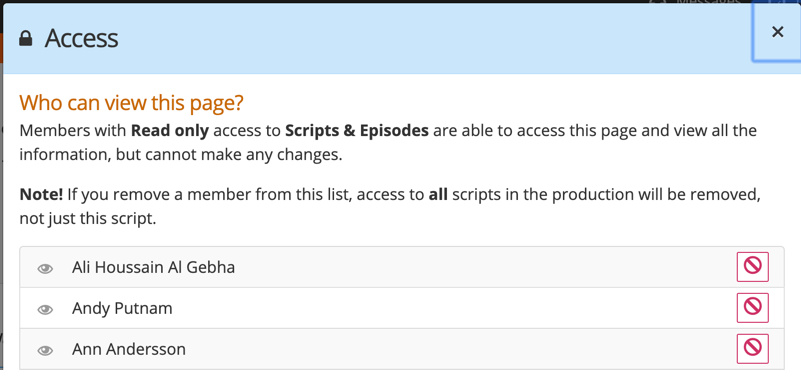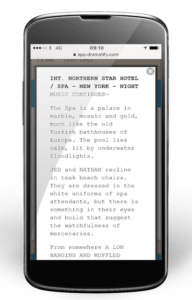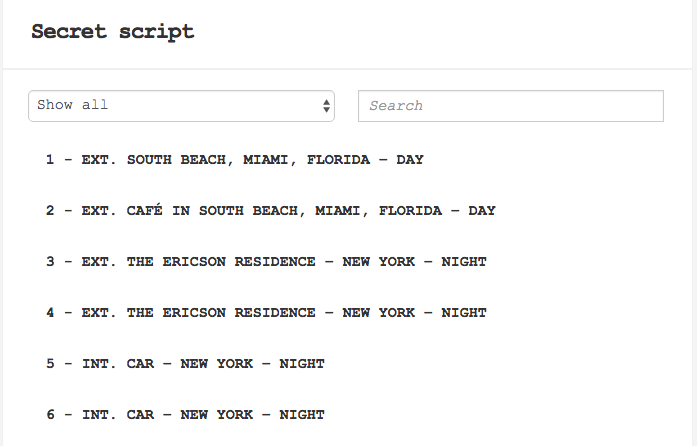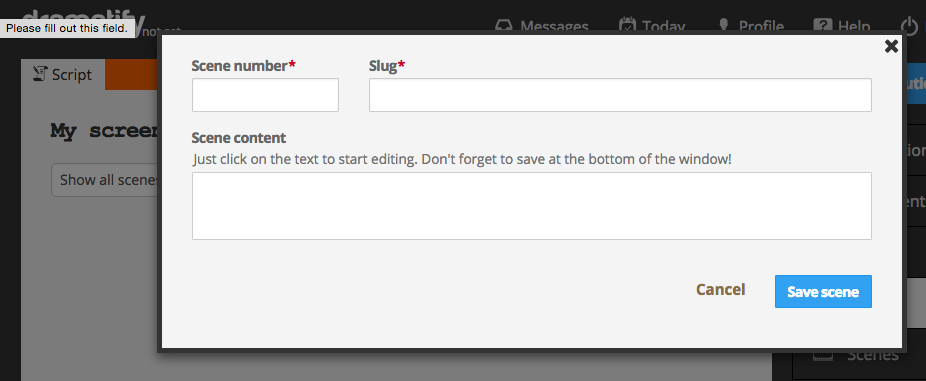How to work with drama screenplays
Import, synch, write, rewrite, watermark, create script sides. Sign up if you haven't already!How to work with drama screenplays
Working with drama screenplays is a breeze in Dramatify. But a screenplay is no longer just a screenplay. It is also the start of an intricate web of links that runs through your entire production to end in script sides and call sheets. And you can do unlimited episodes! Here’s how it works!
Where do I find the script functionality?
Just click on Scripts (or Episodes & Scripts) in the sidebar menu!
In which languages can I write screenplays?
Permissions and access rights for screenplays
How to set permissions
You can either set permissions and access rights for screenplays when you invite a new member to your production, or after you have added a new member.
The functionality to add permissions and access rights are on the first page when you invite a new member, under the section “Permissions“.
If you want to change permissions for an exisiting member of your production, you click on People in the sidebar, find their card and the click on the menu (1) and select Edit member details.

 Permission to read
Permission to read
Underneath the Permissions headline on the member admin page, you’ll find Script permissions. Only members that have Scripts & Episodes > Read only box checked have access to read and print the screenplay.
Note that all team members can read the scene text in the digital call sheet on the day that scene is being shot, under the heading “Shooting Schedule”.
Write, import, edit and delete
Only team members who have the permission box “Scripts & Episodes > Full access” can access edit mode and write, import and edit a script.
Check who can read and edit a screenplay
To check who can read and edit a screenplay, click on the menu button above the screenplay and select Access.

In the popup list, you can first see who has Read-only access. To remove their access, just click on the red button to the right.

In the middle of the page, you can see who can write, edit and import a screenplay. People with a pen icon before the name have read and write access to scripts, while people with a key are admins who have access to all parts of the production. To remove write access to scripts, click on the red button to the right. The person will retain read access and move up the list to the Read-Only section, where you can remove Read-only access as well.

To change permissions for people with Admin access, access their personal cards under People as described above and remove admin access.
Reading scene scripts in the call sheet
 If you have turned off access to the script section, all team members will be still able to read the script of each scene in the call sheets after you have published them, but only in the order you shoot them. You can also remove access for cast and crew that are only engaged for a few days.
If you have turned off access to the script section, all team members will be still able to read the script of each scene in the call sheets after you have published them, but only in the order you shoot them. You can also remove access for cast and crew that are only engaged for a few days.
With the scene scripts in the call sheet, you never have to send or print the script or individual scene scripts to the cast and crew. They can read them in their favourite device.
How to work with top secret stories
If your story is super super secret, there is always the option of adding a script that only consists of Scene Headings. You can then use them as place holders for breakdown, scheduling and call sheets and no one in the team will see any part of the script unless you give it to them in some other way.

Multi-script productions – episodes and series
If you need to work with multiple scripts, either as a drama series, or with mixed script formats, for instance using AV scripts to storyboard the screenplay or certain sequences, please learn more about our episode feature.
Writing a screenplay from scratch
To add a drama screenplay, you click on the Scripts tab in the right hand sidebar.
On the script page, you can now choose which type of script you want to add and since we are focusing on drama in this tutorial, we click on Create screenplay.

Just add a title for your screenplay and click save.

As you see, the page is blank apart from the screenplay title, because we have not added any scenes yet. To add a new scene just click the Add scene button and you will activate the editor.
It’s important to understand that Dramatify is not like a regular word processor or screenwriting program where you just write and write.
In Dramatify, think of each scene as its own little container. This means that you easily can start making an outline of the script, add action and later dialogue as well as shift scenes around without any copy and paste. You only need to change scene numbers.
Since Dramatify is an online tool, you can team write from different locales around the world. Just be aware that if you are working on the exact same scene at the exact same moment, you might overwrite what your colleague just wrote depending on who saved last.

Importing a screenplay
Most productions have screenwriters using a professional screenwriting program. To import an existing screenplay, you use a .fdx file format that has been exported from Final Draft or a .fdx compatible program like Scrivener, Storyist, Adobe Story, Trelby or Fade In.
We can not import from Movie Magic Screenwriter, Celtx, Microsoft Word or a pdf for the simple reason that they only export flat text files. Learn more about importing these file formats.
Numbering scenes
If you number your scenes before import, you will have an easier time importing and synching up revisions and rewrites!
Check formatting and scene headers
Also check through your scene headings. A text with a scene heading formatting should only be used to indicate a scene heading, and not for simply getting uppercase letters, as that will make your import and synching process more difficult.
Rebuild your screenplay file
To make sure that your characters and sets are imported AND linked to your scenes, take a moment to make sure your Final Draft file is up to date.
- Go to the Document menu in Final Draft (or your screenplay program) and click on Smart Type.
- In the dialogue box, start by clicking on “Rebuild” on Characters.
- Note that you have to rebuild each category that you’ll see in the dropdown menu in the image below. This makes sure that you have the latest information in the file you import to Dramatify, and not old information.
- Save your screenplay.

Import a screenplay
To import a screenplay, click on Scripts in the sidebar menu, and select Screenplay > Add.

On the next page, add at least title, then click “Save & Go to Final Draft import“.

On the importer page, follow the instructions and select a .fdx file from your computer to import, and click Save. Dramatify will now tell you how many characters, sets and scenes you will import. Click “Start the import”.
Checking through characters
You now get a list of all the characters in the script. If it’s your first script, all the characters will be new, and you only need to categorise them into main characters, supporting, extras, stunts etc.
If you see that the screenwriter have misspelled a name and you have ended up with two characters instead of one, just click “Ignore this character” on the misspelled character and it will not be imported. The same goes for any formatting errors in the original screenplay resulting in other elements being tagged as characters.
If you make a series, Dramatify will automatically recognise characters that already exists and link up previous character information with the new script, thus saving you a ton of work. When you have gone through the character list, click save at the bottom and go to the next page. You should now have a pretty complete character list. If you do not want to import any characters, you can click Skip in the instruction box at the top of the page.
Checking through sets
Sets work pretty much like characters, with the difference that Dramatify tries to determine if a scene is interior, exterior or a combination. Sometimes the ghost in the machine can’t guess and you have to help it by selecting the correct setting for the scene at INT/EXT.
If you have very few or no sets, that means that your original script is not correctly formatted, but you can add those in the breakdown. When done, click save at the bottom and go to the next page. You should now have a pretty complete set list. If you do not want to import any sets,you can click Skip in the instruction box at the top of the page.
Checking through scenes
The last step of the import process, is to check through your scenes. If your screenplay don’t have numbered scenes, click on “re-number scenes” to add scene numbers.
If everything looks as it should, just click to import your script and either go directly to the breakdown or read the script.
If you have formatting errors, that have created a scene where it shouldn’t be one, you can either check “ignore scene” which doesn’t import the scene and it’s content at all, or indicate it’s part of a previous scene.
To indicate that at suggested scene actually is part of a previous scene:
- Remove the scene number
- Check “Part of another scene”
- Write the number of that scene in the box beside “Part of another scene”
- You might have to manually change the following scene numbers
to get all in the right sequence - Click on any of the blue buttons at the bottom to import your script.
Delete imported content
If you find that the script doesn’t look like it should through formatting errors, or you have done a major rewrite and want to start over, you can delete content. Scroll down to the end of the page and read the Delete and Flush content section.
The scene editor
You then write, edit and format your scene as you like. Just click in the scene content text area to activate the format editor. To format or change formatting, simply mark the words or the paragraph and choose formatting in the “styles” dropdown where you’ll find all the common scene formats.
When you are done writing, you save your scene, and repeat to create the second scene.

RTL languages

Editing a scene
To edit the script, just click in the main text area and the editor will appear. As before, mark any text that you want to format or reformat and select the correct formatting.
Moving and renumbering scenes
Normally, screenplays in Dramatify are shooting scripts, therefore renumbering follows industry standards. While you of course can manually renumber your screenplay however you like, scenes are always displayed in number order – unlike a wordprocessor.
To follow industry standard, if you want to move scene 44 to between the existing scenes 39 and 40, you change the scene number to 39 B. A scene between 39 B and 40, becomes 39 C etc.
It is good practice to keep the old scene number,44, and write either OMITTED or MOVED to 39B to communicate to the team what has happened.
Triggering a revision and revision colour
Deleting a scene
This way you inform your team that the scene have been deleted and the scene number order is kept without anyone wondering where the scene have disappeared to, or triggering synching errors with breakdown and scheduling.
Deleting a screenplay
Note that if you delete a screenplay, any work you have done in breakdown, scheduling and other functions, may be affected. If you want to replace a screenplay with a revision, please read on below at “synching a screenplay”.
Change screenplay title
Adding a cover page to the screenplay
Note that if you import a screenplay, a cover page is not included in the import, so you need to create one in Dramatify.

Printing, watermarking and tracking a screenplay

![]()
The Line Counter
How the lines are counted
A line is 60 characters including commas, dots, empty spaces, etc. If the rest of that dialogue line is under 10 extra characters, i.e. below a total of 69 characters, it’s still counted as one line. A dialogue of over 70 characters is counted as two or more lines. A one-word line, i.e. “No” or “Oh” is counted as one line.
In the report, you’ll see the total lines per character and episode. If you do a feature, the line count is presented for the entire film.
Generating Script Sides
The script sides show the scenes you have scheduled, in the scheduling order, regardless of which episode or script order they have.
To automatically generate script sides, click on Scripts (or Episodes & Scripts) in the sidebar menu, and then on Script Sides in the orange toolbar. Select the day or the period for which you’d like the script sides, and optionally also the team.

Distributing script sides
You have two ways of distributing script sides:
- Give Read-only permission to scripts to your cast and crew that should have access to scripts sides (read more above at Permissions and Access rights above)
- Print script sides as a PDF or on paper and distribute as you normally would. To turn off version background colours, make sure “Background Graphics” or “Background Colors” are not checked in the web browser’s print dialogue.
Troubleshooting
If you get the wrong scenes or garbage scenes, you need to go back to scheduling or the script itself. The script side functionality ONLY shows the scene text of the scenes that you have scheduled.
Delete and Flush information
If you have imported a screenplay that is badly formatted, or if you have done a major rewrite, you may want to flush part of the production information.
Go to Production > Settings and scroll down to Delete content from production.Here you can select to delete ALL listed content, or just one script for example as would be typical for a rewrite.

Try Dramatify today - if you haven't already!
30 days free trial! No credit card required.
 Permission to read
Permission to read